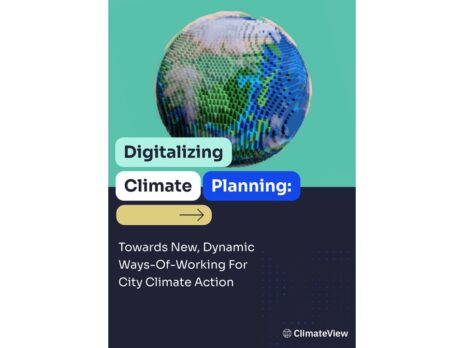

Cities across the globe are struggling to justify the capital they need to cut emissions and support their green transition. With limited funds from traditional tax revenues, looking to the capital markets is a necessary evil. And one that requires cities to have a credible business plan.
With support from digital platforms, cities are preparing to deliver investable plans. ClimateOS from ClimateView provides a data-driven climate action plan that can attract that funding.
Existing users of ClimateOS include Nottingham, Cincinnati and Heidelberg, which use processes to build a strategy and a business case to reach their climate ambitions.
The goal, the strategy and the execution
With any challenge, the best thing to do is to break it down into steps.
Tackling climate change is no different. Any city looking to start its climate journey must begin by setting a goal – in many cases, this will be reaching net zero by a certain date. Once set, it would be best if you planned a strategy for achieving that goal. And finally, you require the means and support to execute on that strategy.
All this is far easier said than done, but if you support this framework with analysis of relevant data and collaborate with key stakeholders – such as local businesses – your chances of success are improved.
New interactive climate plans increase collaboration

The goal
Establishing a sensible climate goal is critical. The target you set will be the primary influence over your climate journey and the call to pull everyone together. Set something unachievable and you risk losing support.
The first step in understanding what you need to achieve is to find your baseline – learn what level of emissions your city is presently responsible for.
City data will typically be incomplete and interpreting it is not an exact science, but if you are able to break down where the largest proportion of your emissions are coming from and agree on what emissions you have material influence over, you will be in a strong position to build a strategy.
For instance, any city has both territorial activity – things happening inside its boundaries – and outer-territorial activity. You also have activities going on that straddle inside and outside of the city – commuter trips, for example.
Defining which activities import or export emissions is important. With some digging, you may find your existing definitions prove to be insufficient.
Combining multiple major factors, such as the notion of consumption-based activity and scope, will show how quickly things get complicated and that, whatever target you set, difficult choices will be made to reduce ambiguities and minimise uncertainty.
The key is to understand the activity and how it is measured. Let’s consider commuting by a fossil-fuel-powered car. The physical act can be measured in terms of kilowatt hours. If you can track, or reasonably estimate, how many kilowatt hours your city is producing and the resultant emissions, you are on your way to building your baseline. Clearly, you need to do this for all activities you deem material.
If your headline ambition is to reach net zero by 2050, such as the UK, you will now be in a position to know the emissions levels you need to reduce.
Transition Elements – plan your transition shifts

The strategy
A city is a complex system. One of the biggest challenges you will face is how you reach your climate goal and establish the levers to do so.
A big question concerns transition: which activity shifts can bring you the biggest impact and at what costs? How can you mobilise other departments, experts and cities to provide practical support?
Thinking about the activities inside a city will help you lower emissions. This could mean replacing those activities with others that fulfil the same need or finding alternative means to fuel those activities.
Keeping with the example of commuting by car, establishing how many commuters there are, how many trips are taken and the average distances for the commutes, will allow you to factor in how investing in more electric buses and routes will influence emissions. This shift is called the rate of change – the transition opportunity.
If you aim to reach net zero, you must make sure that all of these transitions add up to zero or close to zero.
Design your emissions pathways

Of course, any strategies to cut emissions in one activity will surely have implications for other activities, positive or negative. So, it’s important to see how these transitions are connected.
For example, a reduction in car usage with a shift to public transport will reduce energy consumed per passenger kilometre. It would also reduce nitrous oxide emissions, providing a positive secondary impact.
In many cases, the transition requires capital. A big increase in electric bus stock will cost money. This is where you must examine the cost versus the return. Ideally, you are looking to establish if a transition has a positive return on investment, in terms of both expenditure and emissions.
If you want to secure financing to invest in electric bus stock, bus lanes, etcetera, you must convince commuters to change their behaviour, too. It’s not enough to put more buses on the roads – can you ensure journeys are quicker and cheaper?
Calculate the costs and co-benefits

The execution
With all eyes on net zero it’s clear that once a strategy is agreed upon, the fun can begin. During the execution phase, it is important to stay on schedule and ensure the rate of change needed to hit the goal is attained.
There may be many times when a tweak in the strategy is required to maintain positive momentum towards your goal. Having real-time data can be the decisive success factor – whether in national or local execution.
Track-leading indicators

ClimateOS
With ClimateOS, cities are able to connect emissions, actions and economics to create evidence-based net-zero strategies and climate investment plans. ClimateOS lets you understand the full impact of your climate decisions and see connections and trade-offs, the gaps and opportunities.
At the top level, the platform includes four key applications: the city inventory, an online data management platform; pathways, where cities can set their targets and build their emissions and economic scenarios; action planner, where cities can build actions needed to make the strategy come to life; and finally, the investment plan, which calculates the business case for shifting from one activity to another, taking into account the costs and co-benefits, and the project investments needed.







